Table of contents
- Connected motorcycles are coming BMW, Honda, KTM and Yamaha network us
- The motorcycle knows more and more
- Networking roadmap presented
- Who does everything with the CMC?
- What is all of this supposed to bring me?
- Warn or regulate?
- Networked tomorrow?
- opinion poll
- Conclusion
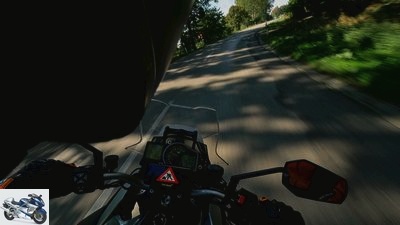
CMC
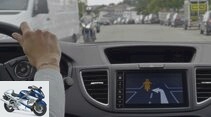



17th pictures
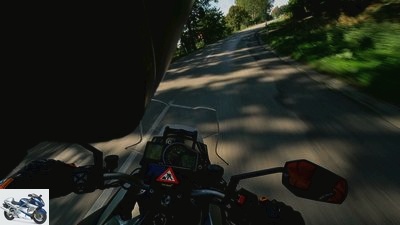
1/17
This is how the warning of an upcoming construction site that was previously not visible on the curve could look like. The key to this, however, is an absolutely precise location of the motorcycle and the construction site via GPS.
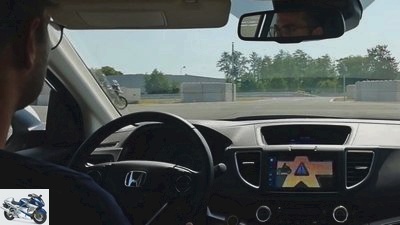
2/17
In the car, too, the motorcyclist must be recognizable via optical and / or acoustic signals. Especially when turning …
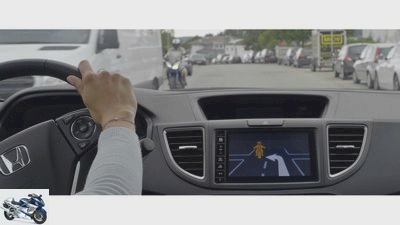
3/17
… or if the motorcycle is invisible behind another vehicle despite the minimum distance.

4/17
Just imagine. The car’s ESP detects a slippery spot on the road and communicates this to the oncoming motorcycle. Great.

5/17
Often tricky: wanting to overtake a slow, large vehicle and not know exactly what is going on in front of the truck. Here, the motorcyclist would be warned about the possible evasion of the truck.
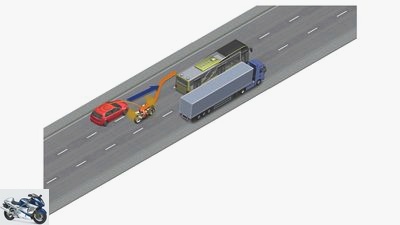
6/17
Classic blind spot warning. However, not via sensors or radar, but via the radio network of the C-ITS and GPS.
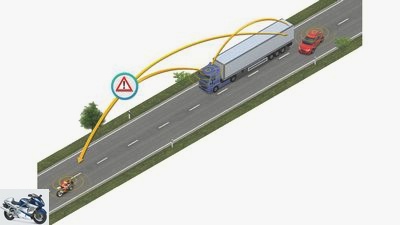
7/17
Conversely, the car is warned of an approaching motorcycle before overtaking.
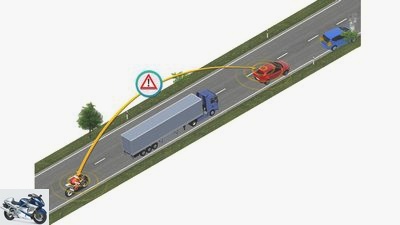
8/17
But the overtaking motorcycle is also warned of the slow traffic in front of the truck.
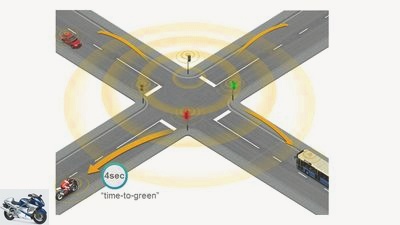
9/17
Nice aspect: In city traffic, all C-ITS vehicles are shown the optimal speed for the green wave.
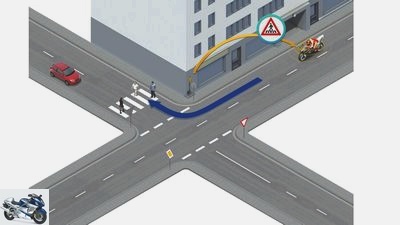
10/17
Via permanently installed antennas, crossing pedestrians can be recognized in good time …
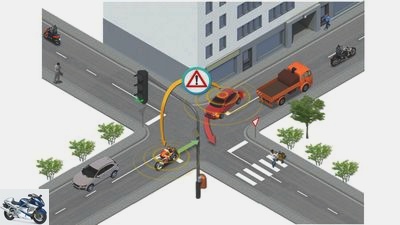
11/17
… or critical turning situations can be defused in good time via the C-ITS network.
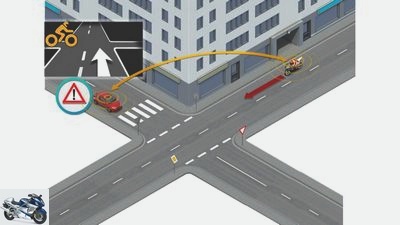
12/17
Conversely, the car is shown the approaching motorcycle well before it reaches the line of sight.
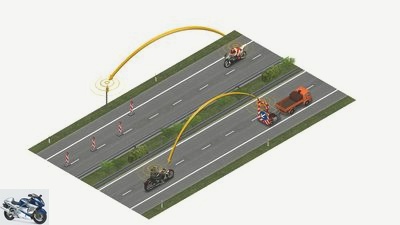
13/17
Brave new world: Construction sites and lane changes are automatically communicated to the motorcycle and all other networked road users.
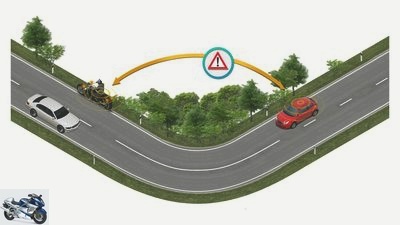
14/17
In the event of a breakdown, you cannot always choose where to stand. Here the motorcycle warns all other vehicles in good time before they reach the danger zone.
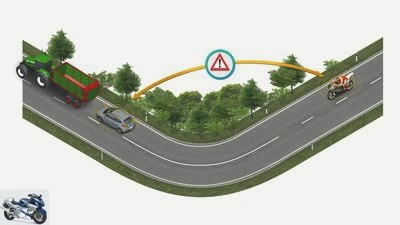
15/17
Also experienced 1,000 times. Sudden rolling obstacles after the turn. It’s nice to be warned in advance from your own bike.
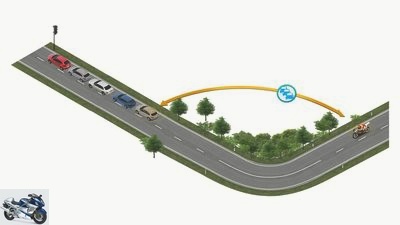
16/17
The same also applies to congestion in front of traffic lights, roundabouts or intersections.
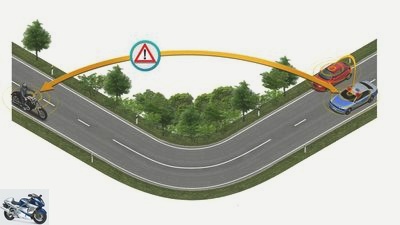
17/17
Another interesting aspect of the C-ITS for motorcycles is the timely detection of approaching rescue vehicles.
counselor
technology & future
Motorcycles are networked for more safety
Connected motorcycles are coming
BMW, Honda, KTM and Yamaha network us
Our mopeds can always do more and are getting smarter and smarter. A joint project of leading motorcycle manufacturers is now promoting the networking of the motorcycle, with the car and the rest of the traffic for more security. BMW Motorrad and Yamaha have now officially confirmed their further cooperation. So there seems to be pressure on the subject.
Jens Kratschmar
01/28/2021
CMC, V2X, C-ITS. No new e-scooter models from Asia, but basic structures such as today’s vehicles communicate with each other and with the environment. CMC is that “Connected Motorcycles Consortium”, an association of leading motorcycle manufacturers for the development and standardization of safety systems that are in exchange with other vehicles. V2X stands for “Vehicle to everything”, in other words, the communication between the vehicle and everything around it. C-ITS further specifies this as “Cooperative Intelligent Transport Systems”, in other words, pure communication between vehicles using GPS as the foundation.
The motorcycle knows more and more
The networking of vehicles for exchange in order to avoid critical situations or purely to increase comfort is already closer in the car than some people think and is a basic building block not only for safety, but also for the big issue of autonomous driving. When it comes to motorcycles, however, such components are only available in rudimentary form in some current top models in the form of radar systems from Ducati, BMW, KTM and maybe Honda. Here, however, communication is one-sided and purely reactive: the radar initially only registers changes in the visible traffic and adapts the speed.
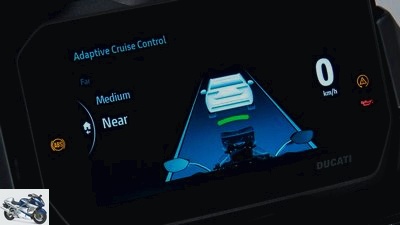
Ducati
The new radar systems are currently the only safety assistants that actively intervene in the driving process using distance cruise control. Basis: The traffic must be visible. C-ITS concentrates on the traffic that is not yet visible
And this is where the big difference to vehicles that communicate using C-ITS via an ad-hoc radio network lies: They don’t see each other at all. Corresponding warnings are exchanged between the vehicles long before they are visible. And it’s not just about critical situations that directly affect a car and a motorcycle. It can also be situations that one vehicle senses and another vehicle warns that this incident could be affected. Example: day construction sites, sudden weather changes or accident sites. The technology behind it requires an absolutely accurate GPS signal as a basis, several GPS antennas are required in the motorcycle and of course absolutely accurate and up-to-date maps for city traffic, otherwise the system cannot work as planned.
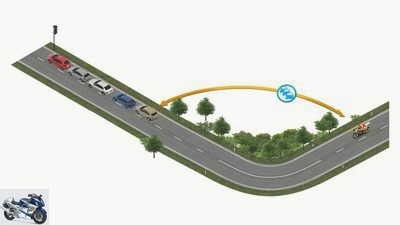
CMC
The same also applies to congestion in front of traffic lights, roundabouts or intersections.
Networking roadmap presented
The CMC has been working on transferring the C-ITS technologies from four-wheelers to two-wheelers since 2016, since the situations that can lead to an accident are different with a motorcycle. Therefore the warnings must also be different. These Basic Specifications, christened by the CMC, have now been presented for the first time and virtually contain the foundation of the C-ITS:
- What kind of accidents could a C-ITS system avoid??
- Which scenarios are based on and through which application in the C-ITS can the situations be addressed?
- What are the system requirements on or in the motorcycle? How many GPS antennas are required where in the motorcycle? What should the security protocols look like??
- How do these systems work in real-time testing on prototypes? Or how long before from do the warnings or notifications have to be communicated to the driver?
- How does the system work in comparison to the other V2X standards such as ETSI or Car 2 Car?
- Human-machine interface: How can the motorcycle reach the driver in time without overwhelming or even distracting?
- How and when can these systems be offered and how much effort is involved?
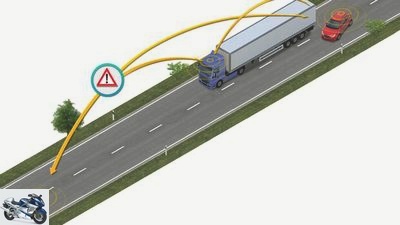
CMC
The car is warned of an approaching motorcycle before overtaking.
Who does everything with the CMC?
The CMC was launched in 2016. Founding members and today’s main members are BMW Motorrad, Honda and Yamaha. Meanwhile also belongs KTM to the core of the CMC. Other members and partners include:
- Alpinestars
- Ducati
- Kawasaki
- Suzuki
- triumph
The other members of the CMC are made up of technical universities, accident research and the automotive industry. Competence is out of the question, at least on paper. Communicate currently BMW motorcycle and Yamaha actively and aggressively on this topic and, according to a press release, both are extending their cooperation with the CMC and the other partners. The next level of the CMC “Next” focuses on the topic of motorcycles’ perception in ADAS (Advanced Driver Assistance Systems), i.e. the existing sensor systems in cars. Mainly radar systems, which are also becoming more and more usable in motorcycles. As a car and motorcycle manufacturer, BMW is playing a dual role and emphasizes the synergies that can be used, particularly in the area of onboard sensors. Above all, the V2X systems as well as the existing sensor systems should be used here “Working hand in hand and not being used as stand-alone systems” announces BMW Motorrad.
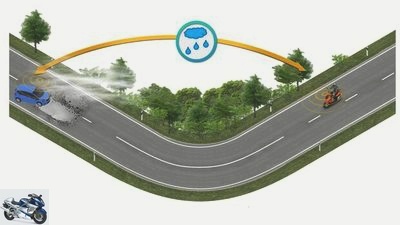
CMC
Just imagine. The car’s ESP detects a slippery spot on the road and communicates this to the oncoming motorcycle. Great.
What is all of this supposed to bring me?
So far, the CMC has identified and named 19 different applications that are to be recognized by the C-ITS and presented to the driver. The 19 applications are divided into three categories such as “See and be seen”, “Expect the unexpected” and “Less stress”. The 19 applications include, for example, an assistant to signal motorcycles behind delivery vans or trucks to a car turning left and at the same time to sensitize the motorcycle to a left turn. Or warnings about possible slippery spots or obstacles and construction sites in advance are also planned. Also interesting from the field “Less stress” the recommendation of the optimal speed on roads with lots of traffic lights to use the green wave. In short: the C-ITS of the CMC should reduce all real pain points and possible hazard scenarios that a motorcyclist as a road user should be avoided as much as possible.
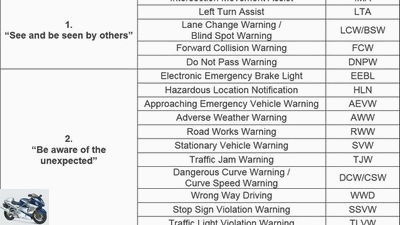
CMC
Here are the 19 applications that the CMC has identified as necessary, divided into three main categories. Unfortunately only in English.
Warn or regulate?
It would of course be conceivable and logical to let the active safety systems work actively with the warning in the motorcycle of a danger zone. So initiate emergency braking as the most tangible example. But before that, a lot of research is needed. The most important thing here is the following: What is the driver doing on the motorcycle? Is he focused or is he enjoying the view? Does he have a firm grip on the handlebars and enough pressure on the notches? This is important because, without an attentive driver, automatic braking would further unstabilize the motorcycle, which tends to topple over anyway, and possibly further promote an accident. This is where – I’m spinning a bit – partner Alpinestars comes into play. The clothing specialist could equip the clothing accordingly in order to make warnings from the motorcycle to the driver tangible or even to evaluate the current position of the driver on the machine in order to make an emergency braking decision. Great world.
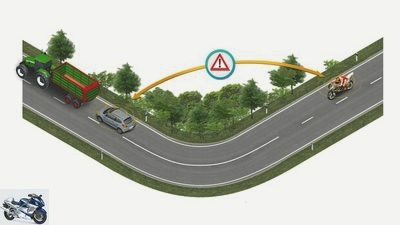
CMC
Also experienced a thousand times. Sudden rolling obstacles after the turn. It’s nice to be warned in advance from your own bike.
Networked tomorrow?
Under no circumstance. The idea of networking for cars is a good 30 years old and only recently have cars been able to communicate on the road, so there can be no talk of market penetration. It won’t take another 30 years for the motorcycle, but it is not to be expected for the next and probably also the next but one generation of models. There is still a lot of work to be done in terms of infrastructure, and national legislation must also be taken into account. Up-to-date road maps are particularly important for determining the exact position of the vehicles, especially in city traffic. In addition, the systems must recognize, for example, whether the motorcycle – regardless of the legal situation – is currently threading its way through a traffic jam so as not to give the signal to the rest of the network: There is no traffic jam or even a supposed message: “Form a rescue lane” triggers.
opinion poll
Voted 1619 times
Connected motorcycles make traffic safer?
Yes, in any case.
No, no system can help without consideration for others.
read more
Conclusion
Technology that makes driving safer. Please, always bring it to me. If someone hit a left turn by a car, my foot, my leg and my intervertebral discs would have been very happy if my colleague in the Passat would have been warned. And as with all active driving safety systems, the same applies here: They work best when you don’t need them. They only have to work best when you need them.
Related articles
-
New Bosch motorcycle safety systems
Bosch 17th pictures Bosch 1/17 To make motorcycling even safer, Bosch is developing numerous new assistance systems. Bosch 2/17 Motorcycles should learn…
-
Active safety systems in motorcycles
Bosch 10 pictures MOTORCYCLE archive 1/10 ABS – Should prevent the wheels from locking when braking hard or on slippery surfaces. KTM 2/10 “Cornering ABS…
-
Motorcycle safety yesterday and today
Security campaign Consideration has right of way Arnold Debus Motorcycle safety yesterday and today Motorcycle safety yesterday and today lead by…
-
Driver assistance systems for motorcycles
Hirano Ami counselor Driving experience & Driving tips Driver assistance systems for motorcycles Assistance systems For comfort and security Motorcycles…
-
Additional safety through assistance systems
Security campaign Consideration has right of way Yixin Chen 7th pictures Yixin Chen 1/7 Bosch 2/7 Adaptive Cruise Control adapts the speed to the flow of…
-
Electronic driver assistance systems for motorcycles
Yamaha 35 pictures www.factstudio.de 1/35 How things are going? It was a long way from the almost purely mechanical cockpit of the Yamaha SR 500 to the…
-
Bosch counselor technology & future eCall systems for motorcycles eCall systems for motorcycles Challenges in accident detection and emergency calls A…
-
Legal requirements for rearview mirrors on motorcycles
Rossen Gargolov counselor traffic & business Legal requirements for rearview mirrors on motorcycles Legal requirements for rear-view mirrors There has to…
-
EU type approval: motorcycles, trikes, quads
fact 9 pictures Bilski 1/9 The motorcycle license is not only a permit to drive on public premises, but also for many people the ticket to freedom. To…
-
BMW motorcycle 38 pictures BMW motorcycle 1/38 BMW fire engine BMW R 1200 RT. BMW motorcycle 2/38 BMW R 1200 RT police motorcycle. BMW motorcycle 3/38…